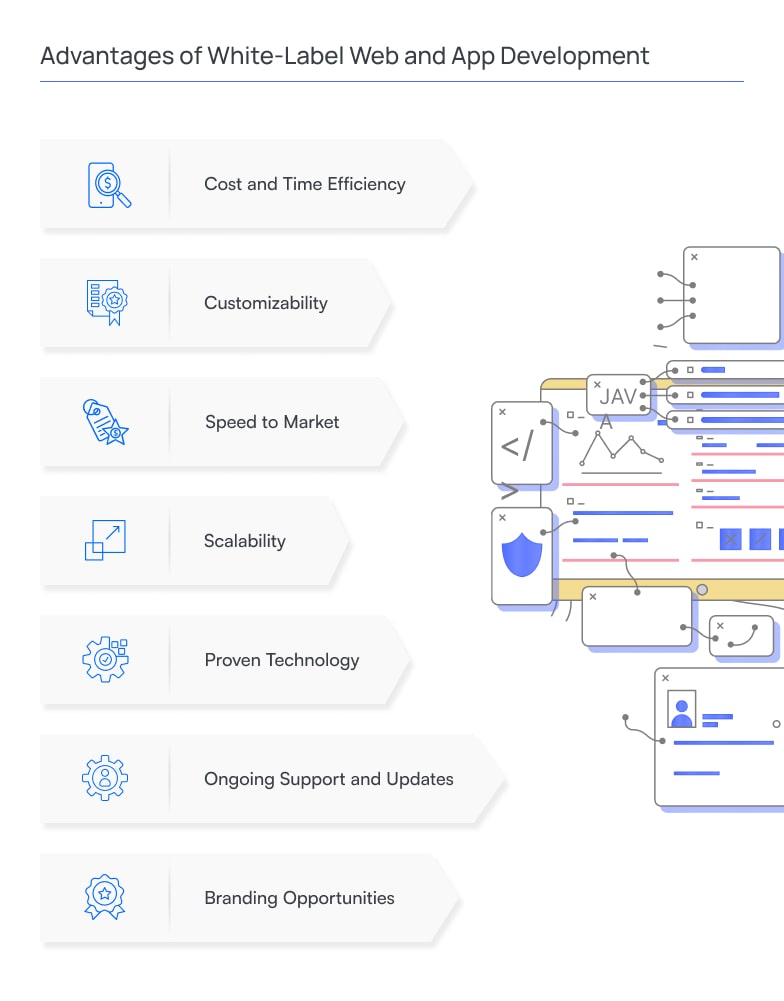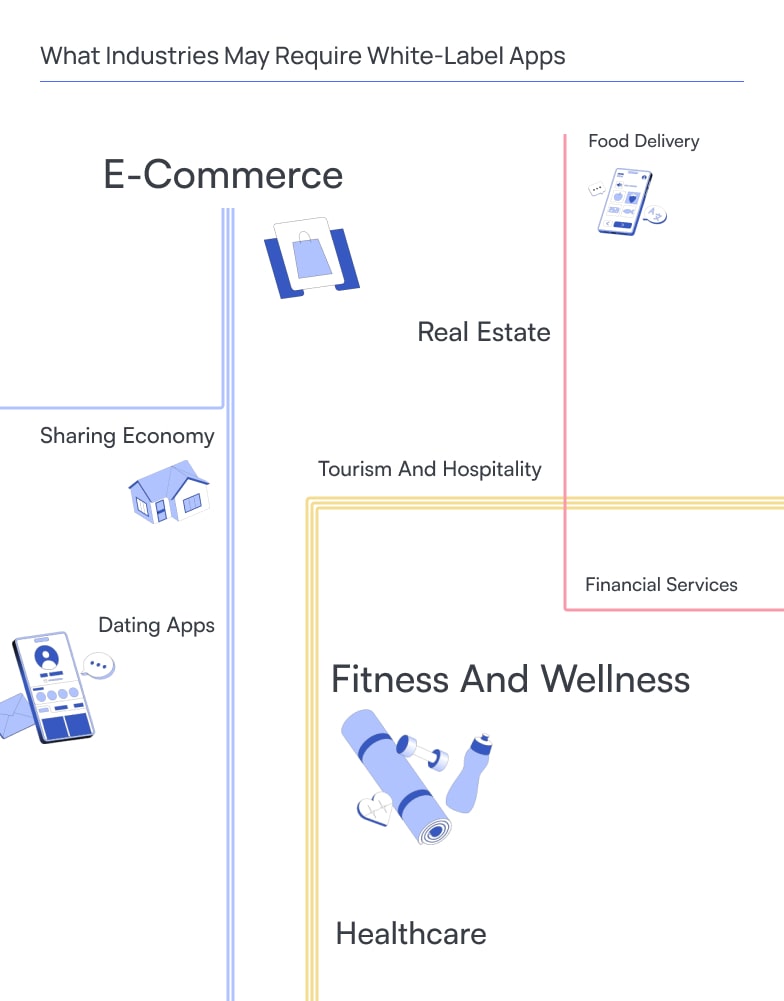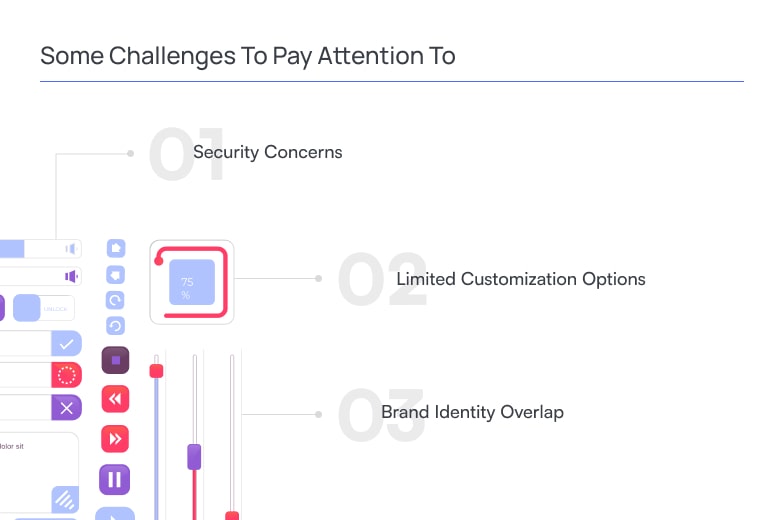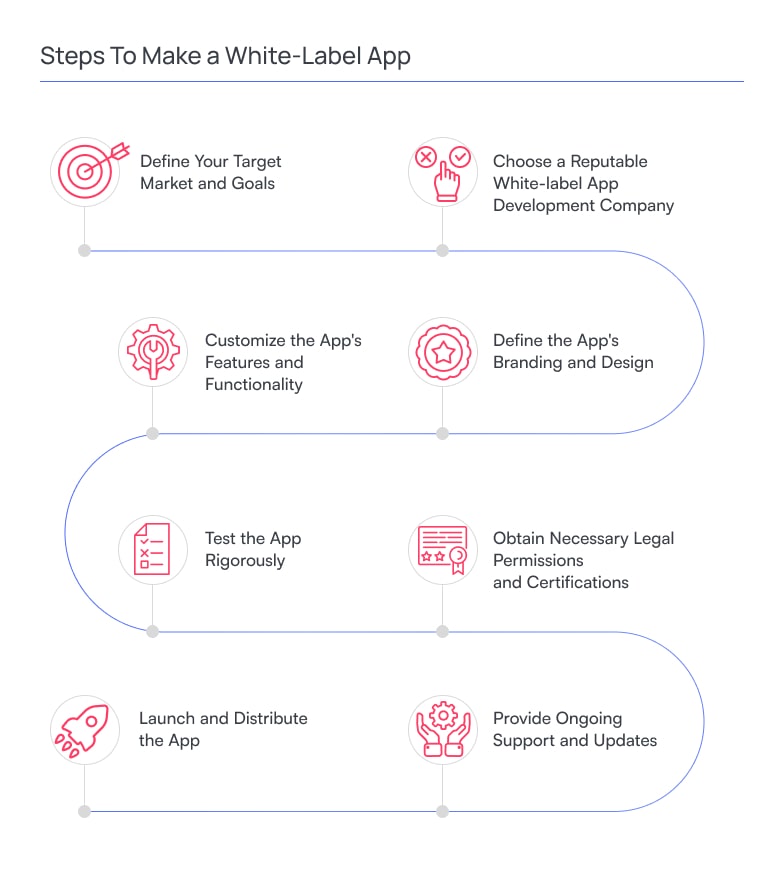Companies often seek efficient and cost-effective solutions to meet their software needs. White-label apps have emerged as a popular option, providing ready-made applications that can be customized and rebranded to fit specific business requirements. However, like any business solution, white-label apps have advantages and disadvantages that must be carefully evaluated.
In this article, we will explore the world of white-label apps, exploring their benefits, the industries they serve, and the revenue models they support. We will also discuss the different types of white-label apps and the implications of choosing between single-tenancy and multi-tenancy options. Besides, you will understand how to make a white-label app effectively.
By understanding the pros and cons of white-label apps, businesses can decide whether this solution aligns with their goals and requirements. Whether you are a startup exploring cost-effective app development options or an established enterprise seeking to expand your product offerings, this article will provide the knowledge to navigate the white-label app landscape effectively.
What Is A White-Label App?
A white-label app is a software product developed by one company and sold to others, who can customize and brand it as their own. This arrangement benefits both parties involved. The white-label app development company only needs to create the software once and can generate revenue by selling it to multiple businesses.
On the other hand, purchasing companies save time and costs by acquiring a ready-made solution tailored to their specific needs. White-label apps find utility across various industries, such as e-commerce, food delivery, sharing economy platforms, and tourism.
For example, suppose you create a white-label app for car sharing. In that case, another company interested in starting a car-sharing business can acquire your app, personalize it with its branding and features, and present it to its users as if it were their creation. It allows you to repeatedly sell the app to similar businesses with minor modifications and unique branding.
The increasing demand for white-label apps stems from companies recognizing the value of offering mobile apps to their customers, thereby driving the growth of this market.
White-Label Apps and Custom Apps: Is There A Difference?
There needs to be more clarity surrounding the definition and differentiation of white-label and custom mobile apps. To grasp the contrast, let’s begin with their shared purpose – both are developed to serve your business and target audience.
Both white-label and custom apps simplify your customers’ lives by providing easy access to information about your business, showcasing products/services, facilitating orders, and resolving issues. Now, let’s explore what sets them apart.
The primary distinction between white-label and custom mobile apps lies in their branding and customization capabilities. A white-label app is specifically designed for branding and customization, allowing you to personalize elements such as colors, logos, and more to establish a unique brand identity.
In contrast, custom apps are exclusively developed to address your company’s specific needs, making it easier to rebrand or modify their appearance with substantial modifications to the underlying code.
Advantages of White-Label Web and App Development
First, let’s explore the benefits of white-label app development and why you should consider it.

Cost and Time Efficiency
White-label apps provide ready-made solutions, saving businesses the time and cost of developing an app from scratch. They can quickly enter the market and focus on their core competencies.
Customizability
Companies can personalize white-label apps by adding their branding, design elements, and functionalities, making them unique to their business and target audience.
Speed to Market
With white-label apps, businesses can rapidly launch their mobile app presence, gaining a competitive edge by reaching customers quickly and efficiently.
Scalability
White-label apps allow businesses to scale their operations without worrying about app development. They can cater to a growing user base and handle increased demand without significant infrastructure investments.
Proven Technology
White-label apps often come with robust features and functionalities that have been tested and proven in the market. Businesses can leverage this technology to provide customers with a reliable and user-friendly experience.
Ongoing Support and Updates
App development companies typically provide ongoing support, maintenance, and updates for white-label apps, ensuring businesses can access the latest features and bug fixes.
Branding Opportunities
White-label apps can be branded with the business’s logo, colors, and overall aesthetic, reinforcing brand visibility and recognition among users.
What Industries May Require White-Label Apps
We will provide just a few examples of industries. However, remember that white-label apps have potential applications in numerous other industries as businesses seek to enhance their digital presence and engage customers through mobile platforms.

E-commerce. Businesses in the e-commerce sector can benefit from white-label apps to offer mobile shopping experiences, facilitate secure transactions, and provide personalized product recommendations.
Food delivery. White-label apps enable restaurants, food delivery services, and aggregators to create branded platforms for online ordering, tracking deliveries, and managing menus.
Sharing economy. Industries such as ride-sharing, scooter-sharing, car rental, and home-sharing can utilize white-label apps to establish their platforms, allowing users to access and use their services efficiently.
Real estate. White-label apps can be customized to reflect the branding and identity of the real estate company. It includes adding the company’s logo, colors, and other branding elements, creating a consistent and professional look and feel across the app.
Custom branding helps establish a strong brand presence and recognition in the market. So you can create a real estate app on a white-label platform.
Tourism and hospitality. Hotels, travel agencies, and tour operators can leverage white-label apps to offer seamless booking experiences, travel guides, itinerary management, and personalized recommendations to enhance the overall travel experience.
Dating apps. White-label apps provide scalability options, allowing dating businesses to expand their services and cater to a more extensive user base without significant infrastructure changes. They can easily add new features, integrate with third-party services, and adapt to changing market demands, ensuring continuous growth and staying ahead of the competition.
If you want to know how to create a dating app, mind reading our detailed article as well.
Fitness and wellness. Fitness centers, personal trainers, and wellness businesses can use white-label apps to provide workout plans, track progress, offer nutrition guidance, and engage with clients through features like booking classes or virtual training sessions.
Financial services. White-label apps are helpful for banks, fintech companies, and payment processors to deliver mobile banking, digital wallet, money transfer, and investment management solutions to their customers.
Healthcare. Healthcare providers, telemedicine services, and health tech companies can utilize white-label apps for remote consultations, appointment scheduling, medical record access, medication reminders, and wellness tracking.
How Is It Possible To Monetize A White-Label App?
There are various revenue models businesses can employ when utilizing white-label apps. These models provide companies with diverse strategies to monetize white-label apps beyond the initial sale, ensuring continued revenue generation and the ability to meet evolving customer needs. Learn more about revenue models if you want to create a white-label app.
Selling Completed White-Label Apps
Businesses can directly sell white-label apps to clients who are seeking specific applications. It can be done through websites, online marketplaces, or app stores like Google Play or the Apple App Store. Highlighting key features and benefits, providing detailed descriptions, and offering demos or free trials can make the app more appealing to potential buyers.
Customizing and Reselling White Label Apps
Digital agencies or software companies can generate revenue by customizing white-label apps with clients’ branding elements and specific functionality requirements and then reselling the tailored app to each client. This approach saves time and resources while allowing the creation of unique apps for different clients.
Fees for Maintenance and Updates
Businesses can provide app maintenance and regular updates by charging clients a recurring fee. Establishing a billing system and offering different pricing tiers based on support levels can ensure a steady income stream while keeping the app up-to-date and bug-free.
Monetizing through In-App Transactions and Subscriptions
White-label app creators can generate revenue by incorporating in-app purchases or subscription options. This model is effective when the app offers valuable services or content. Setting up a billing system within the app allows users to make purchases for additional features or access to content.
At the same time, different pricing tiers or subscription plans cater to a broader range of users. This model also works well for dating apps, for example.
Single-Tenant vs. Multi-Tenant White Label Apps: Things You Should Know
There are two categories of white-label apps that you can create: single-tenant and multi-tenant. The choice between these two types significantly influences the range of features, technical characteristics, development approach, and budget considerations.
Let’s briefly overview both options and explore their distinctive attributes. Furthermore, we’ll present scenarios where a particular type of white-label app may suit your needs.
Single-Tenant Apps
Single-tenancy grants each customer a unique, highly customized white-label app tailored to their specific requirements within the limits of white-labeling. The backend code may be reused with single-tenant apps while the frontend is modified. This approach allows for extensive UI customization options and enhanced user engagement.
Single-tenancy possesses distinct characteristics that differentiate it from multi-tenancy:
- Isolated databases for each tenant on the server.
- Greater customization flexibility, enabling additional features and structural changes that do not impact other tenants. While multi-tenancy also offers customization options, modifications affect all tenants.
- Tenants are free to update their apps independently in the future without any impact on other tenants or the server.
Implementing Continuous Integration and Continuous Delivery (CI/CD) is advisable when developing single-tenant white-label apps. CI involves automatic testing and building code updates in a git repository, while CD facilitates the seamless deployment of changes to the app’s code on the server. The “Continuous” aspect ensures that updates are swiftly deployed after successful testing.
Multi-Tenant Apps
The alternative option is multi-tenancy, which follows a Software-as-a-Service (SaaS) model and supports multiple users or tenants. While the UI design of these apps can be customized, the underlying platform remains consistent across all tenants.
A single server hosts the software in the multi-tenant approach and stores customer data. This option is often preferred due to its ease and cost-effectiveness compared to single-tenancy. However, it also means that any updates or breaches apply to all apps on the server.
Although customization is still available in multi-tenant apps, providers prioritize rapid development and cost-efficiency over extensive customization and personalization.
Maintenance, quality assurance, and testing are streamlined due to the single configuration of these apps. As a provider, you only need to manage one application, and bug fixes are automatically applied to all tenants.
Since multi-tenancy typically involves working with multiple clients simultaneously, creating a tenant onboarding guide can facilitate the process for you and your clients. This guide can include instructional videos, text guides, and dedicated support specialists to assist clients throughout onboarding.
Furthermore, if you opt for multi-tenancy, define the customizable functionality and terms of collaboration in advance and prominently display them on your website or landing page. It allows potential clients to understand what to expect and saves time by addressing any questions regarding additional changes upfront.
Enhance client engagement and boost sales with a white-label app. Let's discuss your options
Contact BineralsSome Challenges To Pay Attention To
Before proceeding to white-label mobile app development, you must know its disadvantages. So check the following challenges.

Security Concerns
When purchasing a white-label app, you only obtain access to the app itself, not the server or source code. As a result, it becomes challenging to assess the reliability of the source code or the security measures in place for storing user information.
Building the app in-house or engaging a dedicated team can help mitigate these risks, as you have direct control over the development process and can ensure the necessary security measures are implemented.
Limited Customization Options
One significant drawback of white-label applications is the limited flexibility for customization. While you can make some changes, such as adjusting colors, adding a logo, or rearranging modules, the level of customization is often restricted. To achieve an app precisely tailored to your needs, it is typically better to build it from scratch.
Alternatively, you can collaborate with a white-label development company to create a custom framework for your brand. Consulting with a white-label developer can provide insights into the possibilities to meet your requirements.
Brand Identity Overlap
With limited options for personalization, there is a risk of your brand identity overlapping with other companies using the same white-label app framework. If another business has purchased the same app framework in the past, it can be challenging to differentiate your brand and app from the competition. The look and format of the app will remain identical, potentially causing confusion among consumers who use both applications. Careful consideration should be given to how your brand can stand out and maintain its uniqueness despite these limitations.
Steps To Make a White-Label App
Creating a white-label app involves several essential steps to ensure its successful development and customization. A comprehensive guide outlines the critical stages of developing a white-label app.

Define Your Target Market and Goals
Start by defining your white-label app’s target market, goals, and objectives. Understand the needs and preferences of your target audience to ensure that your app will meet their requirements.
Research and Select a White-label App Platform
Explore different white-label app platforms available in the market. Assess their features, customization options, scalability, and compatibility with your target market’s devices (such as iOS and Android). Choose a platform that aligns with your requirements and offers the flexibility you need for customization.
Choose a Reputable White-label App Development Company
Select a reliable white-label app development company that specializes in creating customizable apps. Consider their experience, expertise, portfolio, client reviews, and pricing structure. Collaborate with the company to understand their development process and ensure they can meet your specific customization needs.
For example, Binerals always strives for transparency, and we are always ready to prove what we can create. Check our portfolio and read client reviews to ensure we are a reliable team to cooperate with.
Define the App’s Branding and Design
Determine the branding elements that will reflect your company’s identity, such as the logo, color scheme, and visual style. Work with designers to create a visually appealing, user-friendly interface that aligns with your brand guidelines and resonates with your target audience.
Customize the App’s Features and Functionality
Customize the app’s features and functionality to meet the unique requirements of your target market. This may involve adding or modifying features, integrating third-party services, and tailoring the user experience. Ensure that the app provides a seamless and intuitive experience for end-users.
Test the App Rigorously
Thoroughly test the white-label app to identify and resolve any bugs, glitches, or compatibility issues. Conduct comprehensive quality assurance (QA) testing on different devices and operating systems to ensure optimal performance and user satisfaction. Incorporate user feedback to fine-tune the app’s functionality and usability.
This stage is crucial for any app development. For example, you can read the article about location-based app development and see how quality assurance is essential.
Obtain Necessary Legal Permissions and Certifications
If your white-label app involves sensitive data or complies with specific industry regulations (such as healthcare or finance), ensure that you obtain the necessary legal permissions and certifications. It may include complying with data protection regulations and adhering to industry-specific security standards.
Launch and Distribute the App
Once the app development and testing phases are complete, prepare for the app’s launch. Submit the app to relevant app stores, such as Google Play Store or Apple App Store, and follow their guidelines for approval. Implement an effective marketing strategy to promote your white-label app and generate awareness among your target audience.
Provide Ongoing Support and Updates
Offer continuous technical support to clients who purchase and use your white-label app. Address their queries, provide regular updates, and resolve any issues. Stay proactive in incorporating new features, security updates, and improvements based on user feedback and industry trends.
By following these steps, you can create a customized and market-ready white-label app that meets the unique needs of your clients and provides a seamless experience for end users. Remember to adapt and iterate based on feedback and market demands to ensure the long-term success of your white-label app.
White Label App Development Cost: How It Can Be Estimated
The development costs for a white-label app can vary widely depending on several factors. However, to give you a rough estimate, here are some approximate cost ranges based on industry averages:
Basic white-label app. The cost for a simple white-label app with basic features and minimal customization can range from $5,000 to $20,000. It typically includes branding, basic UI/UX design, integration of essential functionalities, and testing.
Medium complexity white-label app. For a white-label app with moderate complexity, more advanced features, and a higher level of customization, the cost can range from $20,000 to $50,000. It includes additional features like user authentication, payment gateways, social media integration, and custom UI design.
Complex white-label app. Suppose you require a highly customized and feature-rich white-label app with advanced functionalities such as geolocation, real-time messaging, complex user interfaces, and extensive backend integration. In that case, the cost can exceed $50,000 and go up to several hundred thousand dollars.
It’s important to note that these are just approximate cost ranges and can vary significantly depending on the specific requirements of your project, the complexity of the features, the platforms you’re targeting (iOS, Android, or both), the development resources you choose, and other factors.
So let’s sum up the main factors that can influence the cost of developing a white-label app:
Design and UI. The level of customization and complexity involved in designing the app’s user interface (UI) and user experience (UX) can impact the cost. Highly customized and visually appealing UI/UX designs may require more time and effort from designers, leading to higher development costs.
Platforms and devices. Developing a white-label app for multiple platforms like iOS and Android can increase the overall cost. Each platform may require separate development and testing efforts.
Additionally, supporting various devices, including different screen sizes and resolutions, can add to the development costs.
Note! You can save substantially if you build a cross-platform app – then the cost of your final white-label app will be more affordable. Binerals is an expert in cross-platform software development.
Third-party integrations. The complexity and cost can increase if your white-label app needs to integrate with third-party services or APIs. The effort required to establish and maintain integrations with external systems or services will impact the development cost.
Customization options. The level of customization options provided to clients using the white-label app can affect the development cost. Apps that offer extensive customization features, allowing clients to modify the branding, colors, layouts, and content, may require more development time and resources.
Backend. The complexity of the app’s backend infrastructure, including data storage, security features, and server-side functionality, can impact the development cost.
Apps with advanced backend requirements may require more development hours and skilled resources, resulting in higher costs.
Wrapping Up
White-label app development offers businesses a cost-effective and efficient way to enter the mobile app market. By leveraging pre-built and customizable app solutions, companies can save time and resources while delivering high-quality mobile experiences to their customers.
White-label apps provide a range of benefits, including quick deployment, scalability, and the ability to customize the app’s branding and features. It allows businesses to maintain their unique identity while providing a seamless user experience.
Thus, you can explore the comprehensive white-label app development services of the Binerals company tailored to your unique needs. Together, let’s bring your app idea to life and make a lasting impact in the digital world.
Discover the power of white-label app development for your business. Make your own with Binerals
Contact UsFAQ
What is white-label app development?
White-label app development refers to creating an app that can be rebranded and customized by different businesses or individuals. It involves building a generic app with core functionalities and features, which can then be customized with unique branding elements and tailored to suit the specific needs of different clients.
Why choose white-label app development over building an app from scratch?
White label app development offers several advantages over building an app from scratch. It saves time and reduces costs significantly since the app’s foundation is already built. It allows businesses to quickly enter the market, leverage existing app frameworks, and focus on branding and customization. It also provides scalability options, as white-label apps can be easily adapted and expanded to meet the evolving needs of businesses and their target audiences.
What industries can benefit from white-label app development?
Various industries can benefit from white-label app development. Common examples include e-commerce, food delivery, healthcare, fitness, finance, travel, and dating. White-label apps provide businesses with a cost-effective solution tailored to their industry-specific requirements, allowing them to offer unique app experiences to their customers.
